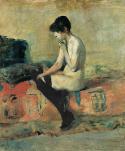Art Of The Day Weekly
#368 - from 11 December 2014 to 17 December 2014
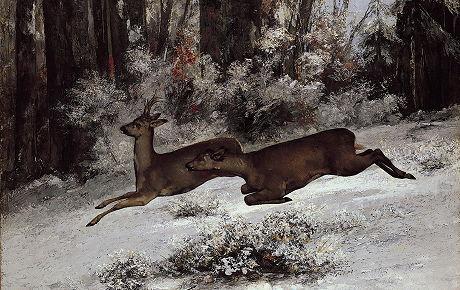
Gustave Courbet, The Ruse, Deer Hunting in the Franche-Comté, 1866, oil on canvas, 97x130 cm © Ordrupgaard Museum, Copenhague (exhibition at Fondation Beyeler, Basel, until 18 January 2015).
IN THE AIR
10 exhibitions not to be missed in Europe
It is Christmas, no time to waste! By writing about three to four exhibitions each week, we have dealt with nearly 60 exhibits since the month of September. In spite of this tight schedule, we did not have time to mention the 10 major exhibits that follow here under. Even with this last minute update we are still far from covering all of them when many will be getting ready to close. We would also have liked to talk about the eccentric Marchesa Casati, the icon of the Roaring Twenties, enhanced in an exhibit at palais Fortuny, in Venice. Or of Sesotris III, the mysterious Pharaoh discovered in Lille, or the most famous works by Courbet and Degas, respectively acclaimed at Basel and Karlsruhe; or even of the incisive Memling, celebrated in Rome, in the native country of so many of his clients at the time. It is increasingly time consuming to discover and enjoy the exhibitions. Here is proof again of that – and a number of ideas to celebrate the holidays as true aesthetes!
IN LONDON
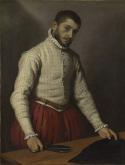
Giovanni Battista Moroni, The Tailor, 1565-70. Oil on canvas, 99.5 x 77 cm. The National Gallery, London Photo © The National Gallery, London.
The human comedy according to Moroni
LONDON -He never left his native Lombardy, or the beautiful town of Bergamo where most of his clients were from. He only pushed so far as Trento, at the time of the Council, to take a number of religious orders. His discreet life and the pitiless competition by his most famous seasoned contemporaries (Tiziano, Tintoretto, Veronese) impacted the fame of Giovanni Battista Moroni (1520-1578), who remained fairly unknown by the public at large. It is a shame for he is one of the pioneers of realistic portraits. His gallery of celebrities includes old wise men, women with dazzling dresses, aristocrats and artisans. It is unique, and announces both the naturalism of Caravaggio and bourgeois portraits of the 19th century.
• Moroni at the Royal Academy of Arts, 25 October 2014 to 25 January 2015.

Joseph Mallord William Turner, Fishermen on the Lagoon, Moonlight, 1840. Watercolour on paper. Support: 192 x 280 mm. Accepted by the nation as part of the Turner Bequest 1856.
Turner at the end and always
LONDON -Given his popularity, he is the first of those masters the public will run for no matter what angle of his work is put forward. Following “Turner and the sea” last year at Greenwich, here we have “Late Turner”. The great Hokusai pretended his own painting only became interesting after he himself turned 70. So be the case for Turner, who got better with time. Only after he turned 50, and even into his 60s, did his touch become revolutionary, in which he diluted any over descriptive element into a vibration that always surprised (not always pleasantly) his followers. Whether painting rearranged Italian landscapes, an anchored ship or a train piercing through the fog, he reinvented the actual notion of atmosphere. Was he pre-Impressionist? Or rather pre-Abstract? These matters are too delicate and do not find one single answer. We shall let each viewer make up his own intimate opinion.
• Late Turner at Tate Britain, 10 September 2014 to 25 January 2015.
Constable, the champion of England
LONDON -The curators of this show have no doubt whatsoever. John Constable (1776-1837) is “Britain’s best-loved artist”. It is he who defined for all times the iconic image of the green, wet English landscape, with its tall trees reflected in a grey river, cows grazing behind a fence and a hay cart rolling gently down a hollow road. In order for this contemporary of Turner to create such masterpieces of naturalist precision he revisited the antique masters repeatedly and copied them relentlessly through a revolutionary technique of outdoor oil sketches. The exhibition gives the list of his network of masters, such as Joshua Reynolds, etc. and of collectors, such as George Beaumont, and is centered on the Royal Academy. They all surround the painter, orient him, advise him and buy his works. The conclusion is universal, there is no good painting without good amateurs.
• Constable, The Making of a Master at the Victoria & Albert Museum, 20 September 2014 to 11 January 2015.
IN MADRID
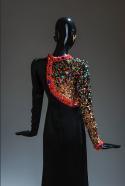
Hubert de Givenchy, Black satin sheth evening dress, semi-bolero effect bodice embroidered with gold an black paillettes and multi-coloured stones, edged with Rosalind coral, Winter 1991. Photo Luc Castel with the collaboration of Philippe Caron
Givenchy, a sacred monster
MADRID - He is of the generation of Courrèges, Cardin and he too does not look his age -87. His talent was revealed very early, as he opened his fashion house at the age of 25. He gave a gust of fresh air to black and knitted a privileged link with the world of movies. His complicity with beautiful Audrey Hepburn whom he dressed in Sabrina, Funny Face and Breakfast at Tiffany’s) gave him world stature as his name appeared in the acknowledgments of the movies he worked for. This exhibition groups together his emblematic models such as the Bettina blouse and also opens an intelligent dialogue with works of art by Zurbarán, Delaunay, O’Keeffe, Ernst or Fontana. Indeed Givenchy is a well-known collector, as we learned after the auction of part of his collection at Christie’s in Monaco in 1993 made the headlines). He would not hesitate to hand a Rothko next to a Boulle wardrobe.
• Givenchy at the Thyssen-Bornemisza museum, 22 October to 18 January 2015.
IN MILANO

Giovanni Segantini, Costume des Grisons (portrait of Barbara Huffer), oil on canvas , 54 x 79 cm, Museo Segantini, St-Moritz, on loan from Fondation Otto Fischbacher-Giovanni Segantini.
Segantini, from Milano to the Alps
MILANO - He shared aspects of his work or themes with Moreau, Millet, Courbet. The first inspired a symbolist vision of the world while Millet bestowed a deep love for Nature, of rural life, and Courbet taught him to express the savage strength of Nature. He died when he was hardly 40 years old, after a difficult youth, having spent some time in a detention center. Italian artist Segantini (1858-1899) found his promised land in the mountains of Engadine, in Switzerland. He transcribed that rough life with a special poetic luminosity. A native of the Trentino region, Segantini made a place for himself in Milano where he studied at the Accademia delle belle arti di Brera. This exhibition, in preview of the Universal Expo in 2015, aims at underlining the role the capital of Lombardy has played as a cultural crossroads. It of course takes this opportunity to show off the artist’s lesser known works - portraits, still lives, church interiors -, from his first Milanese period.
• Segantini at Palazzo Reale, 18 September 2014 to 18 January 2015.

Vincen Van Gogh, The Green Vine, 1888, oil on canvas, 73,5 x 92,5 cm, Kröller Muller Museum, Otterlo.
Van Gogh, a man of the earth
MILANO -Van Gogh, again! But this time the theme is a lot tougher than the eternal shiny Mediterranean with sun flowers and olive trees. Here is man and the soil, in particular the dark and opaque one discovered in the Borinage region with its potato eaters working the merciless land. The painter’s compositions here reflect the black and brown of the labor. This antechamber was maybe necessary so that the contrast of the solar choc would make him lose his mind. The exhibition wishes to show the thread between two periods that seemed so opposite to one another. Even in Provence, the cycle of seasons, of agricultural labor, the rural life remains a fundamental source of inspiration.
• Van Gogh, l’uomo e la terra at Palazzo Reale, 18 October 2014 to 8 March 2015.
IN MUNICH

Bernardo Bellotto, Dresden from the Neustädter Bridgehead, 1765. Oil on canvas, 99.5 x 134 cm © Staatliche Kunsthalle Karlsruhe 2013. Photo by A. A. Fischer/H.Kohler
Bellotto, a second Canaletto
MUNICH - Since he shared his uncle’s love of paintings of canals, he adopted the same name. Hence the fact that Bernardo Bellotto was Canaletto like his uncle, the famous Antonio Canal. The Germans control this complicated situation better than anyone else, since Bellotto (1722-1780) was in fact very active in their country, having lived more than ten years in Dresden and traveled through the country. He went through Munich in 1761 and produced three large views that have just been restored. They of course are the point of departure of this exhibition that shows this travelling painter’s extraordinary talent as a topographer. He was invited to Saint-Petersburg and ended his life in Warsaw. His vedute are not only feats of strength. They are so exact they were used as documents of great importance when it has been necessary to rebuild towns destroyed during the Second World War.
• Bellotto at the Alte Pinakothek, 17 October 2014 to 18 January 2015.
IN PARIS
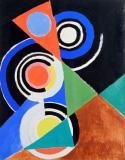
Sonia Delaunay, Composition pour jazz, 2e series, No F 344", Paris 1952 © Pracusa 2013057 © Courtesy Galerie Zlotowski, Paris.
Sonia Delaunay, a woman of many talents
PARIS - For a time she was in the shadow of her own husband. Sonia Delaunay is back in force with a complete retrospective. All the phases of her long itinerary have been studied, from her Ukrainian youth (she was born in Odessa in 1885), up to her death in Paris in 1979, in her last apartment, rue Saint-Simon. Her life was touched by Abstraction but was far from being monotonous given the number of supports she used to express herself– material, clothes, furniture, publications, and even cars, not to mention paper and canvas. She was a friend of Blaise Cendrars, Tristan Tzara, Mallet-Stevens, and was also close to the worlds of theater, movies, monumental decoration (for the Exposition de Paris in 1937). Her universality reminds us of the masters of the Renaissance and was embodied in her apartment on boulevard Malesherbes, a hub for the Parisian intelligentsia between the two world wars.
• Sonia Delaunay, les couleurs de l’abstraction at the musée d’Art moderne, 17 October 2014 to 22 February 2015.
IN TOULOUSE

Benjamin-Constant, Evening on the terraces (Morocco), 1879, Musée des beaux-arts de Montréal, donation by Lord Strathcona and family. Photo MBAM, Brian Merrett
Benjamin-Constant, a perfect academic
TOULOUSE - He has the name of a famous writer from the nineteenth century (who is not read much anymore), with an additional hyphen. Benjamin-Constant (1845-1902) is largely forgotten and only represents for his rare followers the apotheosis of academic painting. In the 1880, he had among his clients the Pope and Queen Victoria. In the preceding decades, he had flirted with the Oriental fashion, and in Delacroix’s traces sketched oueds, souks and dreamlike gynoecium. This very complete retrospective shows the over-cute aspect of his art – but also shows his excellent technique. His images, even when they express cheap sentimentality, are always interesting as documents given the abundance of details and of precision in his colors.
• Benjamin-Constant, Merveilles et mirages de l’orientalisme at the musée des Augustins, 4 Octobre 2014 to 4 January 2015.
IN VIENNA
Toulouse-Lautrec, 150 years later
VIENNA - Can we say anything new about Toulouse-Lautrec? It’s not an easy task. But the simple fact of being limited to the life of Montmartre, to the dancers and easy women is already an audacity in itself. Toulouse-Lautrec would be 150 years old today, which means he would hardly be older than Picasso, who would be 133. Yet he seems to us to belong to another era. It is true that he died in the first year of the XXth century and that he would not experience all the atrocities that would follow– hence no doubt the eternal image of youth, of lightness, provocative, virtues that would not survive the misery of time. This is the most important retrospective ever organized in Austria, with studies of nudes and animals, mundane portraits as well as of the cancan dancer la Goulue. It was about time: in 1900, Vienna was undoubtedly, by its spirit, the European city that was closest to Paris.
• Toulouse-Lautrec at Bank Austria Kunstforum, 16 October 2014 to 25 January 2015.
OPENINGS OF THE WEEK

ANIMA - ZINKPE
13 December 2014 - PARIS - In Situ
Zinkpe, self-taught artist from Benin, creates a world full of colours and strange creatures
IN BRIEF
KIEV - The Future Generation contemporary art prize was awarded on 6 December 2014 by the Victor Pinchuk Foundation to Nastio Mosquito (Angola) and Carlos Motta (Colombia)
LONDON - Rome, From Aventine, sold £30.3 at Sotheby’s on 3 December 2014, set a world record for the artist and the second highest price at auction for an ancient master since The Massacre of the Innocents by Rubens, in 2004.
MARSEILLE – The MUCEM (Musée des civilisations de l’Europe et de la Méditerranée) received the 2014 Museum prize from the Council of Europe.


